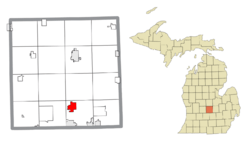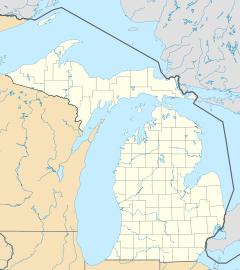DeWitt, Michigan facts for kids
Quick facts for kids
DeWitt, Michigan
|
|
|---|---|
| City of DeWitt | |

Location within Clinton County
|
|
| Country | |
| State | |
| County | |
| Settled | 1833 |
| Incorporated | 1929 (village) 1965 (city) |
| Government | |
| • Type | Mayor–council |
| Area | |
| • Total | 2.98 sq mi (7.72 km2) |
| • Land | 2.84 sq mi (7.35 km2) |
| • Water | 0.14 sq mi (0.37 km2) |
| Elevation | 827 ft (252 m) |
| Population
(2020)
|
|
| • Total | 4,776 |
| • Density | 1,683.47/sq mi (649.94/km2) |
| Time zone | UTC-5 (Eastern (EST)) |
| • Summer (DST) | UTC-4 (EDT) |
| ZIP code(s) |
48820
|
| Area code(s) | 517 |
| FIPS code | 26-22120 |
| GNIS feature ID | 1626182 |
DeWitt is a city in Clinton County, located in the U.S. state of Michigan. In 2020, about 4,776 people lived there. The city is found north of Interstate 69 and west of U.S. Route 127. It is just north of the larger city of Lansing.
Contents
History of DeWitt
DeWitt got its name from DeWitt Clinton, who was the Governor of New York in the 1820s. The first person to settle here was Captain David Scott. He moved from Ann Arbor in 1833. He also created the first maps and plans for the land.
How DeWitt Township Was Formed
The State Legislature officially created DeWitt Township on March 23, 1836. The very first meeting for the township was held at Captain Scott's house on April 8, 1836. At this meeting, Welcome J. Partelo became the township's first Supervisor.
Over time, DeWitt Township was divided into several smaller townships. In 1837, it was split in half, and the western part became Watertown Township. Two years later, it was split again, and the northern half became Bingham Township. Another split happened soon after, making the eastern half Ossowa Township (which was later renamed Bath Township in 1857). The final split happened in 1841, when the northern part of the remaining land became Olive Township. In just four years, DeWitt Township went from covering the entire county to its current size.
County Seat and Growth
DeWitt Township was also where the main government office, called the county seat, for Clinton County was located. This lasted until December 1857. Then, the county seat moved to St. Johns while a new courthouse was being built.
In the early 1900s, the Lansing, St. Johns and St. Louis Railway brought new growth and opportunities to the community. DeWitt officially became a village in 1929. This meant it was no longer fully controlled by the township.
Major Fire and Modern DeWitt
On October 21, 1930, a large fire swept through the main business area of DeWitt. It destroyed eight old and important buildings. This included the Clinton House/Hotel, which was very well-known in the area. The fire caused a lot of damage and slowed down business growth. However, people still built homes there. Because of this, DeWitt started to become what it is today: a "bedroom community" where many people live but travel to other places for work.
The Village of DeWitt became an official city in 1965. In 2005, CNN Money even ranked the DeWitt area as the 75th best place to live in the United States.
Geography of DeWitt
DeWitt covers about 2.99 square miles (7.72 square kilometers). Most of this area, about 2.86 square miles (7.35 square kilometers), is land. The rest, about 0.13 square miles (0.37 square kilometers), is water.
The city is located on the Looking Glass River. This river flows into the Grand River.
Education in DeWitt
DeWitt has several schools that serve different age groups:
- Fuerstenau Early Childhood Center (for Pre-Kindergarten)
- Schavey Road Elementary School (for Kindergarten and 1st grade)
- Scott Elementary School (for 2nd and 3rd grades)
- Herbison Woods School (for 4th and 5th grades)
- DeWitt Middle School (for 6th to 8th grades)
- DeWitt High School (for 9th to 12th grades)
Population Information
| Historical population | |||
|---|---|---|---|
| Census | Pop. | %± | |
| 1880 | 284 | — | |
| 1930 | 476 | — | |
| 1940 | 651 | 36.8% | |
| 1950 | 824 | 26.6% | |
| 1960 | 1,238 | 50.2% | |
| 1970 | 1,829 | 47.7% | |
| 1980 | 3,165 | 73.0% | |
| 1990 | 3,964 | 25.2% | |
| 2000 | 4,702 | 18.6% | |
| 2010 | 4,507 | −4.1% | |
| 2020 | 4,776 | 6.0% | |
| U.S. Decennial Census | |||
In 2010, there were 4,507 people living in DeWitt. There were 1,732 households, and 1,314 of these were families. The city had about 1,576 people per square mile (608 people per square kilometer).
Most people in DeWitt were White (94.9%). Other groups included African American (1.4%), Native American (0.4%), and Asian (0.9%). About 3.5% of the population was Hispanic or Latino.
The average age in the city was 39.8 years old. About 26.6% of residents were under 18. About 9.8% were 65 years or older. There were slightly more females (51.4%) than males (48.6%).
Climate
DeWitt has a humid continental climate. This means it has big changes in temperature throughout the year. Summers are warm to hot and often humid. Winters are cold, sometimes very cold.
Notable People from DeWitt
Many interesting people have connections to DeWitt:
- SungWon Cho: A popular YouTuber and voice actor.
- Dave Cutler: A well-known software engineer.
- Oscar G. Johnson: A veteran of World War II and a recipient of the Medal of Honor.
- Jordyn Wieber: A talented gymnast and Olympic gold medalist.
- Steven J. Glew: A collector who was featured in the Netflix documentary The Pez Outlaw.
See also
 In Spanish: DeWitt (Míchigan) para niños
In Spanish: DeWitt (Míchigan) para niños



